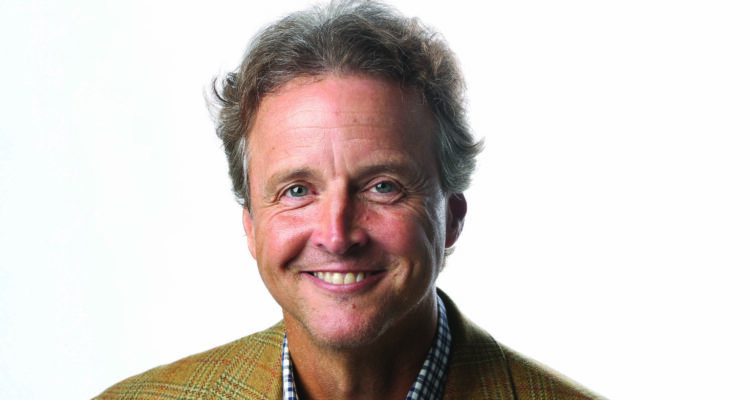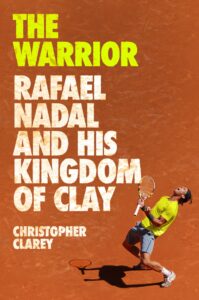WASHINGTON, May 20, 2025 (by Michael Dickens)
It’s been a big and busy week – make that two – for Christopher Clarey. Last Tuesday, ‘The Warrior: Rafael Nadal and His Kingdom of Clay,’ the second book by the longtime tennis columnist and global sports correspondent was published in the United States and Canada, and it reached the United Kingdom on Thursday. Now, he’s on his way to Roland-Garros for the year’s second major of the season, where the Spanish tennis icon, Rafael Nadal, will be honored in a ceremony Sunday commemorating his extraordinary 14 French Open titles.
For Clarey, it’s been a long journey – 22 years in the making and two years writing – covering Nadal, the King of Clay. The book was an independent project – not written with Nadal or his team. While, of course, Clarey informed them he was writing a book on the 22-time major champion, they neither sought nor had any say in the book’s contents.
In ‘The Warrior,’ Clarey went deep on Nadal’s code and his career, and on Roland-Garros, the Grand Slam and the tennis venue. It’s what Clarey calls “the dusty Parisian showplace with which Nadal will always be associated.”
Special event for me at iconic Jabberwocky Bookshop in Newburyport Mass.. Sue Little started it “on a wing & a prayer” 50 years ago & it became a local institution. Thanks to all the #tennis fans who joined us during launch week for The Warrior. Signed copies available there! pic.twitter.com/JMir7B9QfO
— Christopher Clarey (@christophclarey) May 19, 2025
In the past week, Clarey appeared on Tennis Channel and CNN, and also sat for appearances on numerous tennis podcasts on both sides of the Atlantic. He spoke with Sports Illustrated‘s longtime tennis scribe Jon Wertheim and British tennis broadcaster David Law, co-host of The Tennis Podcast, about ‘The Warrior.’
Clarey even made time to visit his local independent bookstore in Coronado, Calif., Bay Books, to sign a few copies of ‘The Warrior’ on the day of its publication before heading east for a book event in Newburyport, Mass. Now, it’s onward to Paris.
On the day before its publication, Clarey spoke via telephone with Tennis TourTalk about ‘The Warrior.’ Here are excerpts (edited for brevity) from our 30-minute Q & A:
How did writing ‘The Warrior’ compare to ‘The Master,’ your book about Roger Federer? Did you go about each of them differently?
“That’s a good question. I have to say, I tried very intentionally to do it differently, because I really realized when I did the first book – which for me was a big change from writing daily journalism – going long-form like that, I just realized how much you really have to live with your project night and day, day and night.
“So, I didn’t want to repeat myself and sort of stay in the same lane and, obviously, Federer already shared a lot of the same real estate over the years and they’re different people, but they had a lot of overlaps. So, I wasn’t sure I was going to do a book on Nadal for that reason. And I wasn’t necessarily looking for the right way through, but it came to me in the sense of … I never wanted to reduce Rafa to a clay-court specialist because he’s not just that. …
“But that number – 14 – as he built that up over the years, it just seemed to me that number was going to live on in memory for a long time, and so I really wanted to be able to – even for me – go back and understand how it was possible. What made it something that could be done?
“And then, I also, I have to admit, I always had felt a really deep connection to Roland-Garros because of my wife being French and my family being French-American, and having lived [in Paris] when I first got married. I lived four or five blocks behind the tournament site in my early years in Paris, so I built a real connection to the place. As you know from talking to me before, I’ve covered many sports all over the world, many different types of sports. But tennis is the one sort of thread in my career all the way through and the tournament – of any tournament and any sport – that I know best is Roland-Garros. So, it just seemed to me with Rafa’s 14 and with the Roland-Garros connection, that the way to do it was to bring them together.
“And, certainly, take in the whole arc of Rafa’s career and try to tell the stories that needed to be told about the matches that you couldn’t miss: The 2008 Wimbledon final, 2010 Australian Open, 2010 US Open, 2012 Australian Open.
“I didn’t want to have a book that didn’t have Rafa’s real highlights and some of his lowlights in it out of the clay, but I wanted the clay to be the main prism. So, that was my conceit, my attempt, and that’s kind of what helped me carry it through. Certainly, to really use the two of them and tell the story of the man and the place and how they kind of merged into one by the end.
“I mean, they won’t maybe remain that way, but certainly at the end of Rafa’s reign, you could not disassociate them, and that statue was quite symbolic of that. … Honestly, unless life spans and health spans increase dramatically, I don’t see anybody getting the 14.”
You wrote over 300 pages for ‘The Warrior.’ Is there a favorite chapter or story – or title won – about Rafa you can share?
“Well, I don’t know, a favorite necessarily from a narrative standpoint.
“I think the first and the last, probably, to be honest with you. I mean, the first, because it was extraordinary to have somebody come into their first French Open and be the favorite, essentially, because he wasn’t seeded first.
“That was Roger, but he was the favorite. in many people’s minds after the number of clay court successes he had. And the reason why it was because [Rafa] ended up not being able to play Roland-Garros in 2003 and 2004 when he could have, because of injuries, So, his natural starting point got delayed, and he was really in a unique position to come into the tournaments of that stature and be the guy to beat. And even more impressive to me was that he was able to finish it.
Only at #RolandGarros
Narrated by @RafaelNadal pic.twitter.com/6O7ZYbkG7Z— Roland-Garros (@rolandgarros) May 12, 2025
“And I think he would tell you that the experience of winning your first major or your first, anything of that stature, is very powerful, and you can feel those emotions there and also it was really uncertain. We just didn’t know what he was capable of. … You just don’t know how they’re going to manage those moments. …
“But the first and the last would be the ones, and I think of his overall titles, I think 2008 [Wimbledon] was for me, still is the one. And I think it’s the logical one and I think it should be just because of the challenge that Federer opposed on that surface. Rafa’s game was especially better for the modern grass-court game than the older grass-court game, but it was an active will, and optimism, and he pulled it off.”
Do you think that because Nadal was so dominant at Roland-Garros on clay that people under appreciated his talent on grass and on hard courts?
‘That’s a good question. I’m not sure I’ve thought of it in those terms. That’s a good way to think about it.
“You know, I think people tended to focus so much on the clay because he was so outrageously dominant on it, it became sort of his signature. So, I think it’s easier to kind of write the other titles a little bit into a separate category and focus more on the clay. I knew that was a risk in writing this book. I didn’t want to end up being one of those who categorized him as a clay-court specialist, focused exclusively on that, and I know that his team and Rafa himself really rejected that approach.
From prodigy, to contender, to champion, to legend.
How lucky we were to see @RafaelNadal‘s career unfold #GraciasRafa | #Wimbledon pic.twitter.com/lZkep0q6kv
— Wimbledon (@Wimbledon) November 19, 2024
“They always tried to see him as an all-court champion – and he was. He won eight majors outside of clay, and eight majors outside of clay would be more than enough for any Tennis Hall of Fame. Oh, for sure, what’s easy to forget is Andre Agassi, Ivan Lendl and Jimmy Connors … they all had eight as well – and that counts all their majors!”
How difficult was it to narrow the focus of the book to 20 chapters, especially since you covered the entirety of Rafa’s professional career during your tenure with the New York Times and International Herald Tribune, and with your subsequent Substack tennis writing?
“It was tricky, and that’s one of the big challenges with writing these two books. You have these long, long careers that are very well documented, and I wrote literally thousands of stories about Rafa and Federer in my time with the New York Times and the International Herald Tribune. So, how do you whittle that down? How do you focus?
“ I think in a sense, having clay be the prism not only kept it fresh, but it probably gave me a little bit more narrow focus on, which was good, and allowed me to break it out, talk about things outside of the clay. I think having that be the main thing and that tournament being the main approach allowed me kind of cut down some of the things that you otherwise would have had to include or would have felt compelled to conclude. So, I think that was a good thing. But it was hard. These guys played a long time and they played so many epic matches.
As you all know, @rolandgarros is the most special tournament of my career.
Thanks to everyone who created this special place in the museum located in the @rnadalacademy with such great memories ☺️. I hope you like it as much as I do.
See you in Paris on Sunday! pic.twitter.com/TAJ1FghgI6
— Rafa Nadal (@RafaelNadal) May 19, 2025
“Rafa didn’t have some of the big changes in his life that Federer did or some things Djokovic did. He had more continuity because of his background in Majorca and keeping his circle pretty tight – and pretty much the same circle – even adding a guy like [Carlos] Moya was somebody he’d known since he was a kid. So, he’s not taking a big, big reach out of his team like Federer at a times and Djokovic has done a lot. There were fewer twists and turns, maybe on the personnel side to chronicle with Rafa, but so much tennis and so much exploration of the mentality.
“It was, I thought, I enjoyed having the dual structure of Roland-Garros, clay and then Rafa, and we got it going in and out on each. …
“There was a real, I think, narrative beauty to being able to tell the whole story.”
Do you plan to complete the Big Three trilogy and write a book about Novak Djokovic?
“That’s a great question. I love the question. I mean, I hope people have an appetite for it.
“I don’t know what I’m going do. As I told you when we started talking today, I did Nadal’s book because I told you I had a fresh way of doing it for a good narrative that would work and hold that year to two-year enthusiasm. You get old when you write a book like this! That same thing applies to Djokovic. I mean, for sure, you can’t not think about it.
Thank you for pushing me to the very limit so many times in our rivalry that has impacted me the most as a player. Your passion for representing Spain has always been remarkable. I wish you best possible farewell in Malaga with Davis Cup team of Spain. I will be there in person… pic.twitter.com/IDglB3h2Rw
— Novak Djokovic (@DjokerNole) October 10, 2024
“And honestly, Michael, I’m hearing that question all through this month, “When is No. 3 coming? So, it’s a little scary to me having the energy it took to do this one.
“I can’t rule it out, and if I get the right format and the right idea, I would definitely be tempted because I got to say. I’ve covered many athletes – many tennis players in my career – and Djokovic is probably the most intriguing and complex personality in a lot of ways I’ve come across at the elite level. It’s just he’s a really an enigma wrapped in a mystery at times, but also somebody I had a lot of chances to get to know early in his career. As well, just like Nadal and Federer, I saw his evolution. So, we’ll see.
“I think right now, it sounds like a big mountain to climb and I wouldn’t mind staying at sea level for a little while. But it’s tempting.”
Thank you very much for your time, Christopher. All the best to you.
“Thank you, Michael. All the best to you.”






